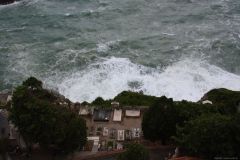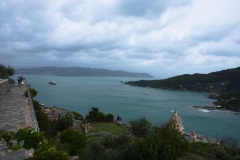Porto Venere is a historic coastal town in northwestern Italy, located at the eastern edge of the Ligurian coast near the Gulf of La Spezia. It lies at the transition between the open Ligurian Sea and the sheltered waters of the gulf, directly opposite the islands of Palmaria, Tino, and Tinetto. The town is built on a steep rocky promontory, with densely packed buildings rising above the harbor and cliffs dropping sharply into the sea. Porto Venere forms part of the cultural landscape of eastern Liguria and is closely connected to maritime activity, coastal defense, and seafaring traditions. Its dramatic setting, where urban fabric, cliffs, and sea are tightly interwoven, gives the town a distinct character shaped by both natural and human forces.
History
The area around Porto Venere has been inhabited since antiquity, with early settlements linked to maritime routes and coastal defense. During Roman times, the site was associated with a sanctuary dedicated to Venus, from which the town’s name is derived. In the early medieval period, Porto Venere developed as a fortified settlement, reflecting its strategic importance at the entrance to the Gulf of La Spezia.
From the 12th century onward, Porto Venere came under the control of the Republic of Genoa and played a key role in Genoese maritime defense against rival powers, particularly Pisa. Fortifications, churches, and city walls were constructed to protect the harbor and promontory, many of which remain prominent features today. The town functioned as both a military outpost and a commercial harbor supporting fishing and regional trade.
Following the decline of Genoese maritime power, Porto Venere lost much of its strategic significance but retained its identity as a fishing and coastal community. In the modern era, the town has become closely associated with cultural tourism and heritage preservation. Together with the Cinque Terre and nearby islands, Porto Venere was designated a UNESCO World Heritage Site, recognizing its historical, architectural, and landscape value.
Geology
Geologically, Porto Venere lies within the complex tectonic zone of eastern Liguria, where the Apennine mountain system meets the Ligurian Sea. The bedrock consists primarily of sedimentary and metamorphic rocks, including limestone, dolomite, and sandstone units that have been folded, faulted, and uplifted during the Alpine and Apennine orogenies.
The rocky promontory on which Porto Venere is built is composed largely of resistant carbonate rocks, which form steep cliffs and rugged coastal morphology. Marine erosion, wave action, and chemical weathering have shaped the shoreline, creating sea caves, vertical rock faces, and narrow inlets. The nearby islands share similar geological characteristics and represent erosional remnants of the same structural units.
Thin soils, steep slopes, and active geomorphological processes such as rockfall and landslides have strongly influenced settlement patterns and construction techniques. The geology of the area has necessitated compact urban development and extensive use of stone in architecture, while also contributing to the dramatic visual contrast between land and sea.
Things to See
Porto Venere offers a range of cultural and natural features closely tied to its history and geology. The Church of San Pietro, dramatically positioned on a rocky headland above the sea, is one of the town’s most iconic landmarks and illustrates the integration of architecture with coastal geology.
The historic town center features narrow streets, tall tower houses, and remnants of medieval fortifications reflecting Genoese urban and defensive design. Doria Castle overlooks the harbor and provides insight into the town’s military past as well as panoramic views of the coastline and islands.
Boat routes and walking paths provide access to the islands of Palmaria, Tino, and Tinetto, which offer views of rugged cliffs, coastal vegetation, and marine environments. The surrounding coastline and sea caves highlight ongoing marine erosion processes and contribute to Porto Venere’s reputation as one of Liguria’s most striking coastal landscapes.






